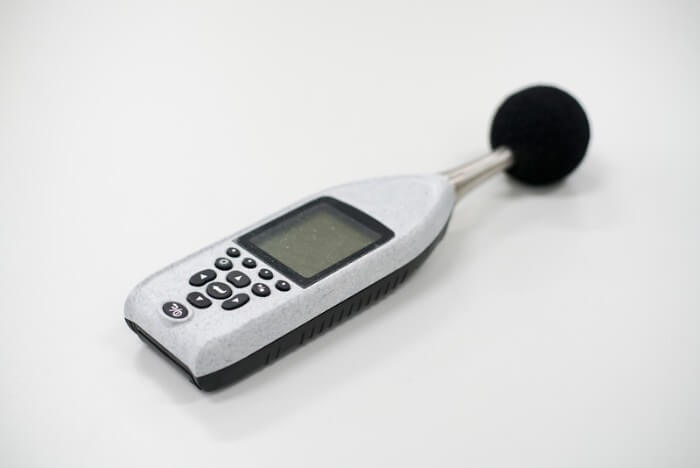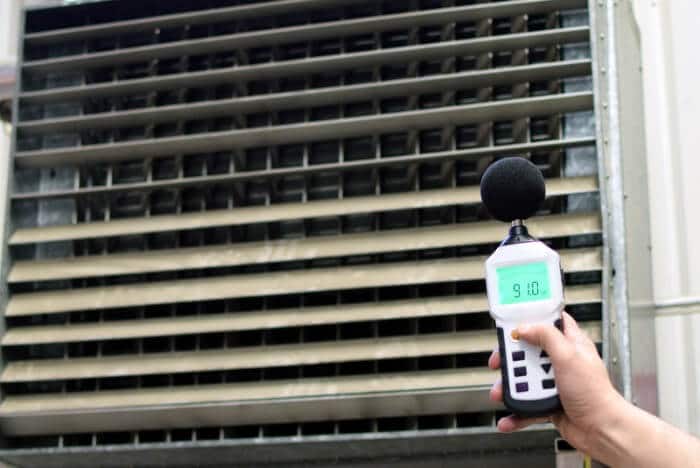STC stands for Sound Transmission Class and is a rating of how well a structure reduces the transmission of airborne sound (also known as attenuation). The higher the STC, the better the barrier is against sound.
When STC is talked about, it is mostly related to doors, walls, ceilings and windows. Calculating the STC is relatively straightforward as you simply need to measure the decibels on each side of the wall and calculate the transmission loss to then compare this to the Standard STC reference.
Knowing this rating makes all the difference when you are looking to soundproof your home as it lets you know what you are working with. Let’s look at how STC is determined and why it matters.
STC Scale
All products use the same STC rating scale so it is easy to understand the effectiveness of each product in blocking noise and you can directly compare different products.

The transmission loss is the reduction in noise or decibel reduction (dB) so the decibels are measured in the room of the source of the sound and then the decibels are measured in the next room along (separated by the wall that is being tested) and the difference in the sound is the transmission loss.
The transmission loss values are tested against different frequencies to create a curve on a graph. This curve is then compared to the STC reference curves and the closest resembled curve on the graph represents the STC rating of the wall.
How to Calculate STC:
If you are trying to calculate the STC of a wall yourself you will need to have a device that measures in decibels (such as a sound level meter) so you can take readings from different positions.
Follow these steps to calculate the STC rating of a wall:
1. Measure The Sound In The Room Where The Noise Source Is
Take a measure of the sound in the room where the source of the sound, such as a TV, is. (for best results, take the measurement very close to the wall).

2. Measure Sound On The Other Side Of The Wall
Now, go to the other room and measure the sound on that side of the wall. The sound you are testing needs to remain the same frequency during both these measurements.
3. Workout The Transmission Loss
You can now subtract the second number from the first to get the transmission loss.
4. Repeat With A Range Of Different Frequencies For More Accurate Results
If you can test a range of frequencies this will give you a better end result. Test several different frequencies and calculate the transmission loss for each.
To accurately work out what the real STC rating is you should test at 16 different frequencies ranging from 125Hz to 4000Hz, however for most people this is not practical. The best way to get a STC rating number which is useful to your situation is to measure a sound that is the same frequency as whatever your usual sound problem may be.
Your average transmission loss number is your rough STC rating (an accurate STC rating would be carried out in a lab with carefully controlled variables but for msot of us that isn’t an option).
Rating and Effectiveness
STC ratings range from 20 to 65, the higher the rating the more sound that is blocked. Below is a summary of the common ratings and how soundproof they are.
- 25 – Talking can be heard and understood.
- 30 – Loud talking can be heard and understood.
- 35 – Loud talking can be heard but not understood.
- 40 – Loud talking can be heard faintly.
- 45 – Talking cannot be heard but music and heavy traffic can be heard.
- 50 – Loud sounds are faintly heard.
- 60+ Most sounds such as traffic and music cannot be heard.
As you can see, 25 and lower offers little to no soundproofing while 60+ offers very effective soundproofing with almost no sound passing through the wall.
To give you an idea of how these figures translate to the real world, a typical interior wall with no insulation offers an STC rating of 35 and a standard single-pane window usually has a rating of up to 27.

The basic STC needs of a normal household are between 50-80.
What Impacts the STC?
There are several factors that can impact the STC rating including:
- Material and wall thickness – the material and thickness of the wall will impact the sounds ability to travel.
- Weak points or ventilation systems – STC rates how airborne sounds travel so any weak areas, gaps and ventilation systems will allow the sound to travel further.
- Frequency of the sound – the STC will differ depending on the frequency of the sound. In a factory, STC will be tested against 16 sound frequencies and the calculated values are compared to an STC standard to get the approximate STC value. In real-life situations, the walls are usually not quite as good as the rating says because they are tested in a controlled environment without any weak points.
How to Improve the STC Rating
STC matters but the best STC rating will depend on your purpose and how much sound you want to block for the room in question.

The best STC rating for a room in a residential home is likely going to be different from an office building or an apartment complex.
Soundproofing your wall will improve the STC rating. Here are a few easy ways you can improve the STC rating of the wall:
- Add mass – a standard rule of thumb is that every time the wall’s mass is doubled its STC improves by 6dB.
- Add soundproofing systems/ absorptive material – adding soundproofing panels to the wall is a relatively low-cost way to reduce the sound that travels through the wall. The soundproofing membrane helps to separate the drywall from studs and will increase the mass of the wall significantly.
- Use lighter gauge studs – simply using lighter gauge studs can be one of the cheapest ways to improve the STC rating of the wall.
- Space out studs – spacing out the studs where possible will also help to increase the flexibility and the STC rating of the wall.
- Increase air space – more air space gives more opportunity for the sounds waves to reduce. Increasing the air space can be a tricky task so professional advice and assistance is recommended.
Summary
STC ratings are very useful but are often not fully understood. Knowing what STC ratings are and how they are calculated will go a long way in helping you effectively soundproof your rooms and stop noise traveling from one room to another.
Of course, there is a range of factors that can impact the STC rating of a wall but the rating will provide you with an average of the soundproofing performance across a range of frequencies.
The STC rating is important to consider before you begin installing soundproofing and hopefully, this guide has given you everything you need to get started.
As an Amazon Associate I may earn a small fee from qualifying purchases at no extra cost to you. This helps us run the site, so thanks for your support!